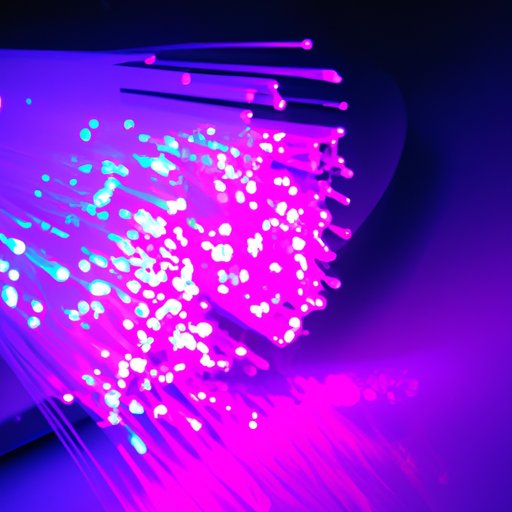Introduction
Fiber optics is a form of data transmission that uses light instead of electricity to move information from one point to another. This technology has become increasingly popular in recent years due to its high speeds, large bandwidths, and low costs. In this article, we will explore how fiber optics work and examine some of the benefits it offers over traditional copper wires.

Explaining the Basics of Fiber Optics
At its core, fiber optics is the use of optical fibers to transmit data. An optical fiber is a thin strand of glass or plastic that is designed to carry light along its length. The light is generated by a transmitter and received by a receiver, which are connected to either end of the fiber.
Light travels through an optical fiber in a process known as total internal reflection. This occurs when light enters the fiber at an angle, and then bounces off the walls of the fiber at the same angle. This allows the light to travel down the fiber without losing any of its energy, meaning that the signal can be transmitted over long distances with minimal loss.
Describing the Components of a Fiber Optic Network
A fiber optic network consists of three main components: transmitters, receivers, and amplifiers. The transmitter converts electrical signals into light pulses, which are then sent down the fiber. At the other end, the receiver converts the light pulses back into electrical signals. Amplifiers can also be used to boost the signal strength if needed.
The transmitters and receivers are typically mounted on small boxes, known as nodes, which are connected to the fiber via connectors. These nodes are often placed at regular intervals along the length of the fiber, allowing the signal to be monitored and adjusted as it travels.
Exploring the Types of Fiber Optic Cables and their Uses
There are two main types of fiber optic cables: single-mode and multimode. Single-mode cables have a very small core diameter (typically 8-10 microns) and are designed for long-distance applications. They are used in telecommunications networks, cable TV systems, and other applications where long distances are required.
Multimode cables have a larger core diameter (typically 50-100 microns) and are designed for short-distance applications. They are often used in local area networks (LANs) and other applications where shorter distances are needed.
Analyzing the Advantages of Fiber Optics Over Copper Wires
Fiber optics offer several advantages over traditional copper wires. For starters, fiber optics can transmit data at much higher speeds than copper wires. According to a study by the University of Southampton, fiber optics can reach speeds of up to 10 Gbps, while copper wires can only reach speeds of up to 1 Gbps.
Fiber optics also offer much greater bandwidths than copper wires. This means that more data can be transmitted over a single fiber than over a single copper wire. Additionally, fiber optics are much less expensive to install and maintain than copper wires, making them a more cost-effective option.

Examining the Process of Sending Signals Through Fiber Optics
Sending signals through fiber optics is a relatively simple process. First, the electrical signal is converted into a light pulse using the transmitter. This light pulse is then sent down the fiber, bouncing off the walls of the fiber as it travels. When the light reaches the other end, it is converted back into an electrical signal using the receiver.
Along the way, the signal can be amplified or monitored using the nodes that are connected to the fiber. This allows the signal to be adjusted if needed, ensuring that it reaches its destination without any loss of data.

Investigating the Future of Fiber Optic Technology
Fiber optics is quickly becoming the preferred method of data transmission, as it offers higher speeds, larger bandwidths, and lower costs than traditional copper wires. As the technology continues to improve, new applications are being developed that take advantage of its capabilities.
In addition, researchers are working on ways to increase the efficiency of fiber optics. For example, a team from the National Institute of Standards and Technology recently developed a new type of fiber that is capable of transmitting data at up to 100 times faster than traditional fiber optics.
Conclusion
Fiber optics is a rapidly growing technology that offers many advantages over traditional copper wires. It is capable of transmitting data at higher speeds, larger bandwidths, and lower costs than copper wires. Additionally, researchers are continuing to develop new applications and technologies that will make fiber optics even more efficient in the future.
(Note: Is this article not meeting your expectations? Do you have knowledge or insights to share? Unlock new opportunities and expand your reach by joining our authors team. Click Registration to join us and share your expertise with our readers.)
